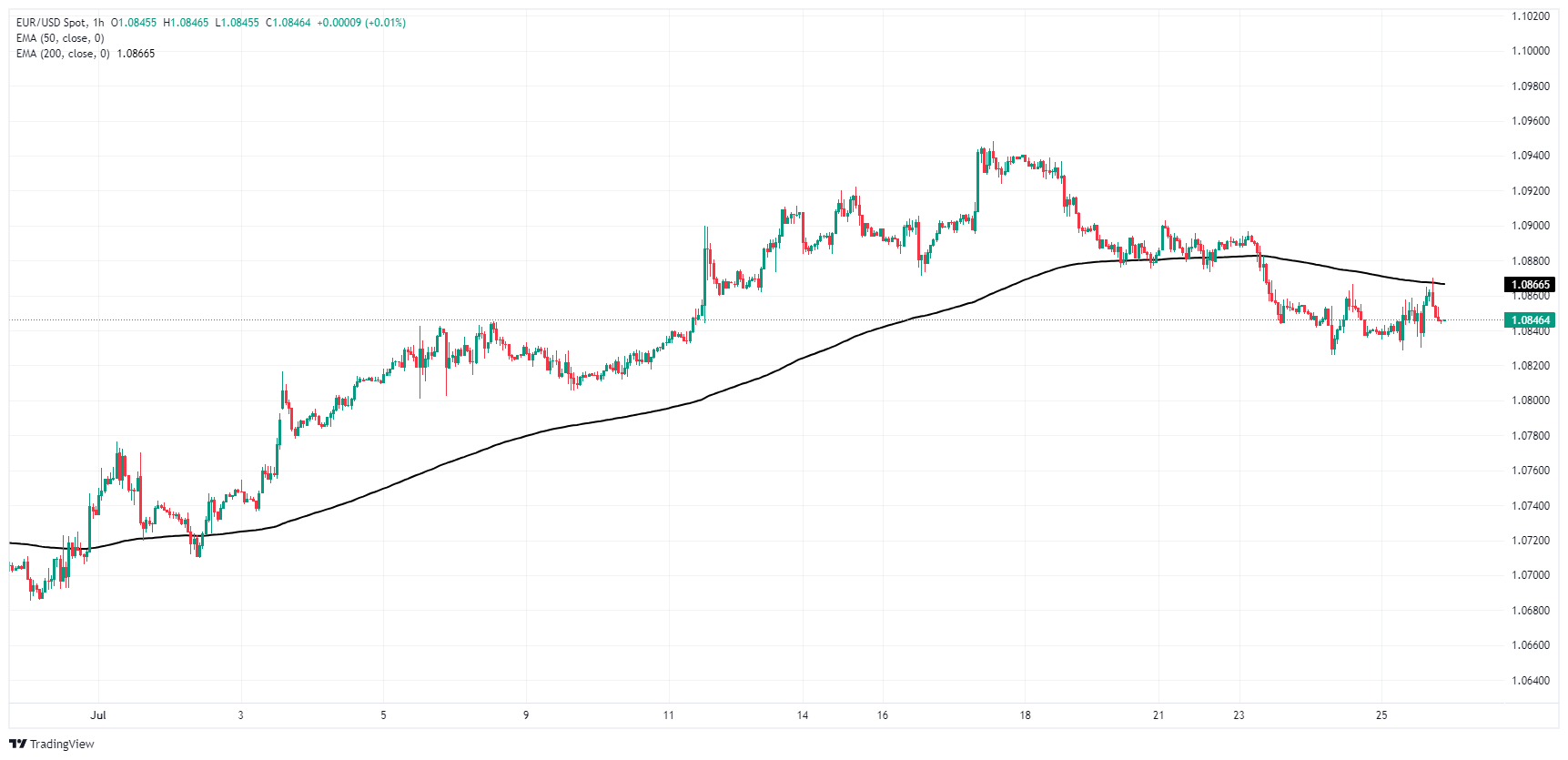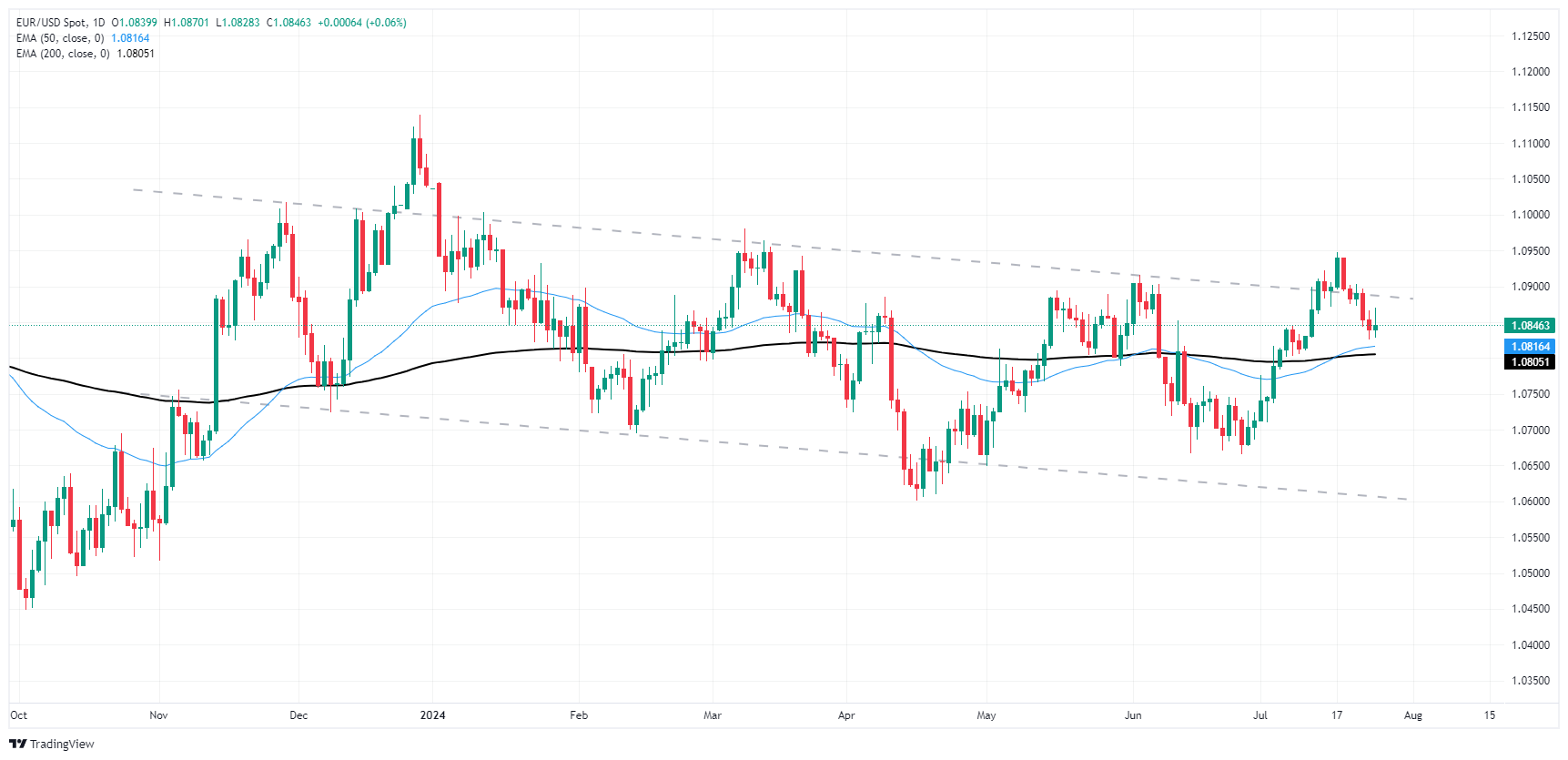- EUR/USD continued to cycle 1.0850 on Thursday.
- Markets are bracing for one last blast of US inflation data on Friday.
- Euro traders hold steady ahead of next week’s GDP update.
EUR/USD churned in familiar territory on Thursday as markets grappled with a lopsided US data print. Broad-market expectations for a September rate cut from the Federal Reserve (Fed) are still pinned to the ceiling, but there’s nowhere to go but down as US data continues to catch investors off-guard. Euro traders will have to wait for next week’s pan-EU Gross Domestic Product (GDP) update, and next Wednesday’s latest Fed rate call looms large over the horizon.
Forex Today: Can US PCE confirm a rate cut in September?
Friday is going to be a decidedly USD-centric affair with US Personal Consumption Expenditure Price Index (PCE) inflation in the barrel. Markets are hoping for a continued cooling in the Fed’s favored inflation metric, with median forecasts calling for core PCE inflation to tick down to 2.5% YoY in June compared to the previous print of 2.6%.
Euro traders will have to swim in circles while waiting for EU data that will move the needle. Pan-EU GDP figures for the second quarter are slated for next Tuesday. QoQ Q2 EU GDP is forecast to shift lower to 0.2% from the previous 0.3%.
The Fed is still broadly expected to keep interest rates unchanged in July at 5.5%, with rate markets broadly focusing on a September rate trim. At current cut, the CME’s FedWatch Tool shows rate traders are pricing in 100% odds of at least a quarter-point decline in the Fed’s benchmark rate on September 18.
US Gross Domestic Product (GDP) lurched higher in the second quarter, bringing annualized Q2 growth to 2.8%, well above the forecast 2.0% and piling onto the first quarter’s 1.4%. Markets initially recoiled from the firm upswing in growth figures, but a sharp contraction in US Durable Goods Orders helped keep hopes pinned for softening data to help push the Federal Reserve (Fed) toward a September rate cut.
Economic Indicator
Core Personal Consumption Expenditures - Price Index (YoY)
The Core Personal Consumption Expenditures (PCE), released by the US Bureau of Economic Analysis on a monthly basis, measures the changes in the prices of goods and services purchased by consumers in the United States (US). The PCE Price Index is also the Federal Reserve’s (Fed) preferred gauge of inflation. The YoY reading compares the prices of goods in the reference month to the same month a year earlier. The core reading excludes the so-called more volatile food and energy components to give a more accurate measurement of price pressures." Generally, a high reading is bullish for the US Dollar (USD), while a low reading is bearish.
Read more.Next release: Fri Jul 26, 2024 12:30
Frequency: Monthly
Consensus: 2.5%
Previous: 2.6%
Source: US Bureau of Economic Analysis
After publishing the GDP report, the US Bureau of Economic Analysis releases the Personal Consumption Expenditures (PCE) Price Index data alongside the monthly changes in Personal Spending and Personal Income. FOMC policymakers use the annual Core PCE Price Index, which excludes volatile food and energy prices, as their primary gauge of inflation. A stronger-than-expected reading could help the USD outperform its rivals as it would hint at a possible hawkish shift in the Fed’s forward guidance and vice versa.
EUR/USD technical outlook
Fiber traders took a break from shorting on Thursday, giving the Euro a chance to catch its breath as the pair holds on the low side of a pullback from recent highs near 1.0950. The pair has fallen back into a rough descending channel, but daily candlesticks have thus far refused to pare back to the 200-day Exponential Moving Average (EMA) at 1.0795.
Buyers will be looking for a chance to reverse course and drag price action back into the high side and break 2024’s slow death spiral, but bearish momentum remains high and EUR/USD could see an extended backslide to the year’s lows below the 1.0700 handle.
EUR/USD hourly chart
EUR/USD daily chart
Euro FAQs
The Euro is the currency for the 20 European Union countries that belong to the Eurozone. It is the second most heavily traded currency in the world behind the US Dollar. In 2022, it accounted for 31% of all foreign exchange transactions, with an average daily turnover of over $2.2 trillion a day. EUR/USD is the most heavily traded currency pair in the world, accounting for an estimated 30% off all transactions, followed by EUR/JPY (4%), EUR/GBP (3%) and EUR/AUD (2%).
The European Central Bank (ECB) in Frankfurt, Germany, is the reserve bank for the Eurozone. The ECB sets interest rates and manages monetary policy. The ECB’s primary mandate is to maintain price stability, which means either controlling inflation or stimulating growth. Its primary tool is the raising or lowering of interest rates. Relatively high interest rates – or the expectation of higher rates – will usually benefit the Euro and vice versa. The ECB Governing Council makes monetary policy decisions at meetings held eight times a year. Decisions are made by heads of the Eurozone national banks and six permanent members, including the President of the ECB, Christine Lagarde.
Eurozone inflation data, measured by the Harmonized Index of Consumer Prices (HICP), is an important econometric for the Euro. If inflation rises more than expected, especially if above the ECB’s 2% target, it obliges the ECB to raise interest rates to bring it back under control. Relatively high interest rates compared to its counterparts will usually benefit the Euro, as it makes the region more attractive as a place for global investors to park their money.
Data releases gauge the health of the economy and can impact on the Euro. Indicators such as GDP, Manufacturing and Services PMIs, employment, and consumer sentiment surveys can all influence the direction of the single currency. A strong economy is good for the Euro. Not only does it attract more foreign investment but it may encourage the ECB to put up interest rates, which will directly strengthen the Euro. Otherwise, if economic data is weak, the Euro is likely to fall. Economic data for the four largest economies in the euro area (Germany, France, Italy and Spain) are especially significant, as they account for 75% of the Eurozone’s economy.
Another significant data release for the Euro is the Trade Balance. This indicator measures the difference between what a country earns from its exports and what it spends on imports over a given period. If a country produces highly sought after exports then its currency will gain in value purely from the extra demand created from foreign buyers seeking to purchase these goods. Therefore, a positive net Trade Balance strengthens a currency and vice versa for a negative balance.
Information on these pages contains forward-looking statements that involve risks and uncertainties. Markets and instruments profiled on this page are for informational purposes only and should not in any way come across as a recommendation to buy or sell in these assets. You should do your own thorough research before making any investment decisions. FXStreet does not in any way guarantee that this information is free from mistakes, errors, or material misstatements. It also does not guarantee that this information is of a timely nature. Investing in Open Markets involves a great deal of risk, including the loss of all or a portion of your investment, as well as emotional distress. All risks, losses and costs associated with investing, including total loss of principal, are your responsibility. The views and opinions expressed in this article are those of the authors and do not necessarily reflect the official policy or position of FXStreet nor its advertisers. The author will not be held responsible for information that is found at the end of links posted on this page.
If not otherwise explicitly mentioned in the body of the article, at the time of writing, the author has no position in any stock mentioned in this article and no business relationship with any company mentioned. The author has not received compensation for writing this article, other than from FXStreet.
FXStreet and the author do not provide personalized recommendations. The author makes no representations as to the accuracy, completeness, or suitability of this information. FXStreet and the author will not be liable for any errors, omissions or any losses, injuries or damages arising from this information and its display or use. Errors and omissions excepted.
The author and FXStreet are not registered investment advisors and nothing in this article is intended to be investment advice.
Recommended content
Editors’ Picks
USD/JPY holds losses near 153.50 after Tokyo inflation data

USD/JPY is licking its wounds at around 153.50 after reversing sharply from 154.00 in early Asian trading. The pair came under renewed selling pressure after Tokyo's core inflation continued to rise in July, backing the case for a BoJ rate hike next week.
AUD/USD steadies near 0.6650, as markets turn cautious ahead of US PCE

AUD/USD sellers take a breather near 0.6650, refraining from placing fresh bets ahead of the US PCE inflation data. Continual weakness in China's economy paired with depreciating iron ore prices remains a major contributor to the recent decline in the Aussie.
Gold price finds support above $2,350, traders eye PCE data

Gold price is holding its modest recovery above $2,350 in early Asia on Friday. Gold price tumbled to a two-week low on Thursday after the US economy fared better than expected in Q2 2024, raising doubts on the scope of the Fed rate cuts this year. US PCE inflation awaited.
Celebrity meme coins lose their shine

Celebrity meme coins report by Jupiter Slorg on Thursday shows that these tokens have been in deep waters since early July after experiencing heavy growth in June.
Will financial markets get some relief as the week closes out?

There’s been no let-up in global growth worries this week and risk off price action has intensified as best reflected through more weakness in US equities. The latest concerns come from discouraging US earnings, ineffective China monetary policy easing efforts, and distressing data out of the Eurozone and UK.